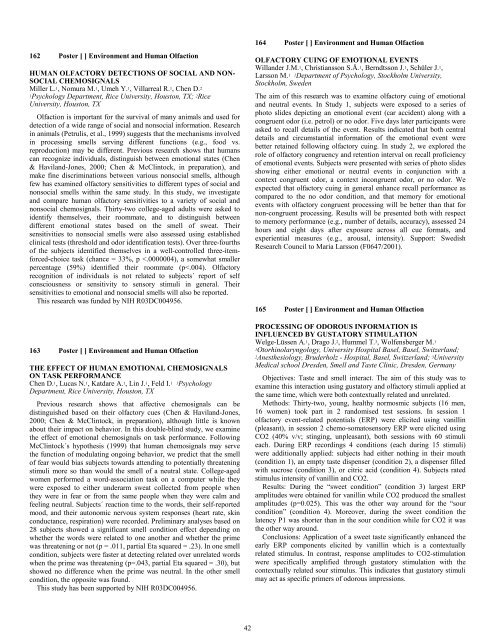Givaudan-Roure Lecture - Association for Chemoreception Sciences
Givaudan-Roure Lecture - Association for Chemoreception Sciences
Givaudan-Roure Lecture - Association for Chemoreception Sciences
Create successful ePaper yourself
Turn your PDF publications into a flip-book with our unique Google optimized e-Paper software.
162 Poster [ ] Environment and Human Olfaction<br />
HUMAN OLFACTORY DETECTIONS OF SOCIAL AND NON-<br />
SOCIAL CHEMOSIGNALS<br />
Miller L. 1, Nomura M. 1, Umeh Y. 1, Villarreal R. 1, Chen D. 2<br />
1Psychology Department, Rice University, Houston, TX; 2Rice<br />
University, Houston, TX<br />
Olfaction is important <strong>for</strong> the survival of many animals and used <strong>for</strong><br />
detection of a wide range of social and nonsocial in<strong>for</strong>mation. Research<br />
in animals (Petrulis, et al., 1999) suggests that the mechanisms involved<br />
in processing smells serving different functions (e.g., food vs.<br />
reproduction) may be different. Previous research shows that humans<br />
can recognize individuals, distinguish between emotional states (Chen<br />
& Haviland-Jones, 2000; Chen & McClintock, in preparation), and<br />
make fine discriminations between various nonsocial smells, although<br />
few has examined olfactory sensitivities to different types of social and<br />
nonsocial smells within the same study. In this study, we investigate<br />
and compare human olfactory sensitivities to a variety of social and<br />
nonsocial chemosignals. Thirty-two college-aged adults were asked to<br />
identify themselves, their roommate, and to distinguish between<br />
different emotional states based on the smell of sweat. Their<br />
sensitivities to nonsocial smells were also assessed using established<br />
clinical tests (threshold and odor identification tests). Over three-fourths<br />
of the subjects identified themselves in a well-controlled three-item<strong>for</strong>ced-choice<br />
task (chance = 33%, p

















